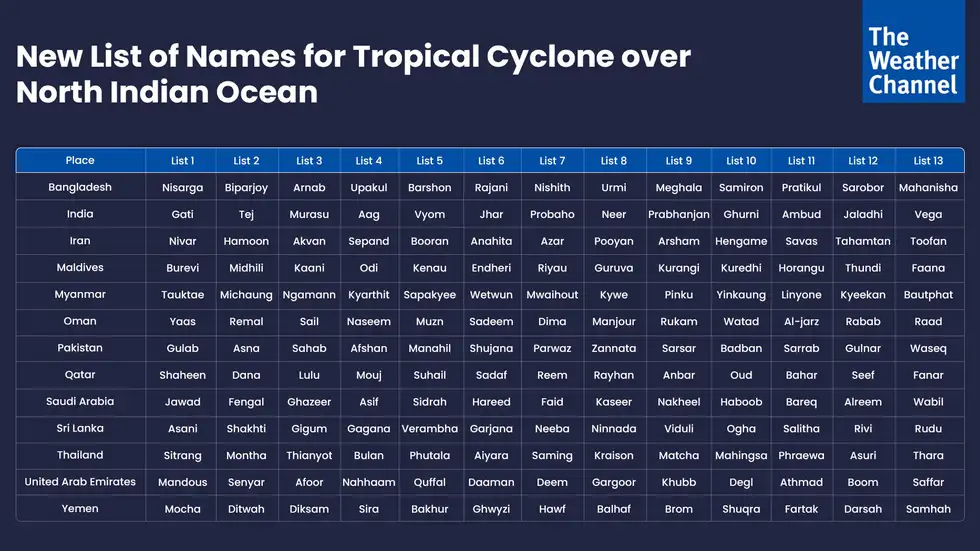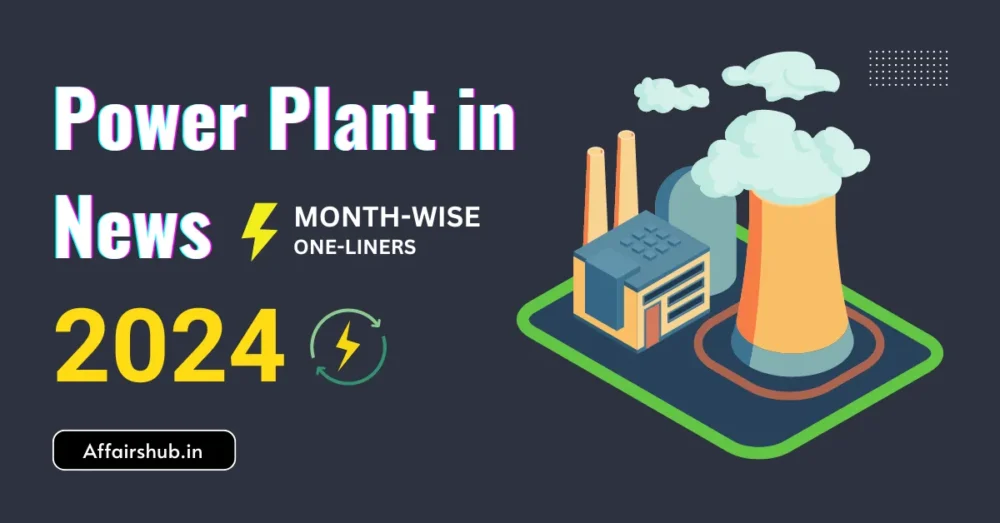In today’s article, I have provided some details about the Upcoming Cyclone in India in very simple language which is very important for various competitive exams.
▪ After reading this article you will know the following details___
- Who names tropical cyclones?
- How are cyclones named?
- Why is naming cyclones important?
- Upcoming Cyclone in India 2023
- The function of the Regional Specialized Meteorological Centre
The following types of questions are asked on this topic in competitive exams.
1. Recent cyclones in the news.
2. Areas affected by the cyclone
3. Which country named the cyclone?
Now, Read the following article to learn all about cyclones in India.
Upcoming Cyclone in India 2024
| Sl. No. | Cyclone Name | Name given by |
|---|---|---|
| 1 | Asna | Pakistan |
| 2 | Dana | Qatar |
| 3 | Fengal | Saudi Arabia |
| 4 | Shakhti | Sri Lanka |
| 5 | Montha | Thailand |
| 6 | Senyar | United Arab Emirates |
| 7 | Ditwah | Yemen |
| 8 | Arnab | Bangladesh |
| 9 | Murasu | India |
| 10 | Akvan | Iran |
✅ Read Also: List of GI Tag Products in India: Complete Details with MCQs
Recent Cyclones around the World
- Tropical Cyclone Alvaro made landfall in Madagascar.
- Madagascar has experienced the impact of Tropical Cyclone ‘Gamane’, killing at least 18 people and displacing thousands more.
- Severe Tropical Cyclone “Megan” has made landfall in Australia.
- Cyclone ‘Hidaya’, a severe storm, is expected to hit the coast near Dar es Salaam, associated with Tanzania.
- Cyclone Remal is likely to cross between Bangladesh and West Bengal coasts, and it is named by Oman.
Most Recent Cyclone
Cyclone Remal
Cyclone Remal was a moderately intense and deadly tropical cyclone that affected West Bengal and Bangladesh in May 2024. Here are the key points:
Formation and Landfall
- Remal was the first depression and the first cyclonic storm of the 2024 North Indian Ocean cyclone season.
- It formed on May 24, 2024, and landed on West Bengal’s Sundarban Delta on May 26 as a severe cyclonic storm.
- During landfall, its wind speed ranged between 100 and 135 kilometers per hour in the coastal area.
Impact
- Remal caused fatalities in both India and Bangladesh, with at least 84 people losing their lives (65 in India and 19 in Bangladesh).
- Approximately 30 million people in Bangladesh and West Bengal were affected by power outages due to the cyclone.
- The overall damage was estimated at $594 million (2024 USD).
Meteorological History
- After four months of inactivity, the India Meteorological Department (IMD) began monitoring a cyclonic circulation in the Bay of Bengal on May 21.
- The cyclone’s impact was significant in both countries, leading to evacuations and rescue operations.
Naming
- The name ‘Remal,’ means ‘sand’ in Arabic.
- This name is part of a list the World Meteorological Department (WMO) created for tropical cyclones in the North Indian Ocean.
- The Cyclone name ‘Remal’ was given By Oman.
Cyclone in India 2023
| Sl.No | Cyclone Name | Name given by the Country |
|---|---|---|
| 1 | Mocha | Yemen |
| 2 | Biparjoy | Bangladesh |
| 3 | Tej | India |
| 4 | Hamoon | Iran |
| 5 | Midhili | Maldives |
| 6 | Michaung | Myanmar |
| 7 | Remal | Oman |
| 8 | Asna | Pakistan |
| 9 | Dana | Qatar |
| 10 | Fengal | Saudi Arabia |
Who Names Tropical Cyclones?
- The tropical cyclones forming over different Ocean basins are named by the concerned Regional Specialised Meteorological Centres (RSMCs) & Tropical Cyclone Warning Centres (TCWCs).
- At present Worldwide, there are six RSMCs including the India Meteorological Department RSMC, and six TCWCs mandated for issuing advisories and naming tropical cyclones.
- The Indian Meteorological Department located in New Delhi is responsible for mandating the name of a tropical cyclone and storm developing over the North Indian Ocean region including the Bay of Bengal and the Arabian Sea.
- In the twenty-seventh Session of The WMO/ESCAP Panel on Tropical Cyclones (PTC) held in 2000 in Muscat, the Sultanate of Oman agreed to assign names to the tropical cyclones in the Bay of Bengal and the Arabian Sea.
- The World Meteorological Organization (WMO) and the Economic and Social Commission for Asia and the Pacific (ESCAP) jointly established the Panel on Tropical Cyclones (PTC)in 1972 as an intergovernmental body.
- The naming of Tropical Cyclones over the North Indian Ocean Region started in the year 2004.
- The name of each tropical cyclone proposed by the 13 member countries of the WMO/ESCAP Panel alphabetically.
| Here is the alphabetical list of all the 13 member countries of the WMO/ESCAP panel. |
|---|
| [1] Bangladesh, [2] India, [3] Iran, [4] Maldives, [5] Myanmar, [6] Oman, [7] Pakistan, [8] Qatar, [9] Saudi Arabia, [10] Sri Lanka, [11] Thailand, [12]United Arab Emirates and [13] Yemen. |
✅ Read Also: List of Month-wise State Government Schemes and Campaigns
Six Regional Specialised Meteorological Centres (RSMCs)
| Ocean Region | RSMCs Name |
|---|---|
| South-West Pacific Ocean | RSMC Nadi-Tropical Cyclone Centre, Fiji Meteorological Service |
| South-West Indian Ocean | RSMC La Reunion-Tropical Cyclone Centre/Meteo-France |
| The Bay of Bengal and the Arabian Sea | Tropical Cyclones New Delhi/India Meteorological Department |
| Western North Pacific Ocean and the South China Sea | Tokyo-Typhoon Center/Japan Meteorological Agency |
| Central North Pacific Ocean | Honolulu Hurricane Center |
| The Caribbean Sea, Gulf of Mexico, North Atlantic, and eastern North Pacific Oceans | Miami-Hurricane Center/National Hurricane Center |
Source – RSMC.IMO
List of 6 Tropical Cyclone Warning Centres (TCWCs)
| Region | TCWCs Name |
|---|---|
| Indonesia | Jakarta/Meteorological and Geophysical Agency/BMG, Indonesia |
| Tasman Sea | Wellington/Meteorological Service of New Zealand, New Zealand |
| The Solomon Sea and Gulf of Papua | Port Moresby/National Weather Service, Papua New Guinea |
| Coral Sea | Brisbane/Bureau of Meteorology, Australia |
| The Arafura Sea and the Gulf of Carpenteria | Darwin/Bureau of Meteorology, Australia |
| South-East Indian Ocean | Perth/Bureau of Meteorology, Australia |
Source – TCW.WMO
How are Cyclones Named?
While sending the naming suggestions of each cyclone, those countries have to follow some rules such as:
- The proposed name should be neutral to Politics and political figures, Religious beliefs, Cultures, and Gender.
- The name should be chosen in such a way that it does not hurt the sentiments of any group or population in the world.
- It should not be very rude and cruel.
- It should be short, easy to pronounce, and should not be offensive to anyone.
- The maximum length of the name will be eight letters.
- The proposed name should be provided along with its pronunciation and voice-over.
- The Panel reserves the right to reject any name, if any, of the criteria above is not satisfied.
- The finalized names may also be reviewed during the course of time of implementation with the approval of PTC in its annual session, in case any reasonable objection is raised by any member.
- The names of tropical cyclones over the north Indian Ocean will not be repeated. Once used, it will cease to be used again. Thus, the name should be new. It should not be there in the already existing list of any of the RSMCs worldwide including RSMC, New Delhi.
Why is Naming Cyclones Important?
- Tropical cyclones are named to identify each cyclone.
- Names are easier to remember than numbers and technical terms.
- Additionally, the names make it easier for the media to report on tropical cyclones.
- It also helps create awareness of its development and remove confusion in case of simultaneous occurrence of cyclones over a region.
- Naming cyclones also help remember a cyclone easily, rapidly, and effectively disseminate warnings to a much wider audience.
New list of tropical cyclone names adopted by the WMO/ESCAP Panel
- Here are the 169 (13 countries × 13 columns) new names of tropical cyclones suggested by the 13 member countries of the WMO/ESCAP Panel.
- These names applied to the cyclones over the North Indian Ocean, including the Bay of Bengal and the Arabian Sea.
| Name Given By | Column 1 | Column 2 | Column 3 | Column 4 | |
|---|---|---|---|---|---|
| Country | Cyclone Name | ||||
| Bangladesh | Nisarga | Biparjoy | Arnab | Upakul | |
| India | Gati | Tej | Murasu | Aag | |
| Iran | Nivar | Hamoon | Akvan | Sepand | |
| Maldives | Burevi | Midhili | Kaani | Odi | |
| Myanmar | Tauktae | Michaung | Ngamann | Kyarthit | |
| Oman | Yaas | Remal | Sail | Naseem | |
| Pakistan | Gulab | Asna | Sahab | Afshan | |
| Qatar | Shaheen | Dana | Lulu | Mouj | |
| Saudi Arabia | Jawad | Fengal | Ghazeer | Asif | |
| Sri Lanka | Asani | Shakhti | Gigum | Gagana | |
| Thailand | Sitrang | Montha | Thianyot | Bulan | |
| United Arab Emirates | Mandous | Senyar | Afoor | Nahhaam | |
| Yemen | Mocha | Ditwah | Diksam | Sira | |
| Name Given By | Column 5 | Column 6 | Column 7 | Column 8 | |
|---|---|---|---|---|---|
| Country | Cyclone Name | ||||
| Bangladesh | Barshon | Rajani | Nishith | Urmi | |
| India | Vyom | Jhar | Probaho | Neer | |
| Iran | Booran | Anahita | Azar | Pooyan | |
| Maldives | Kenau | Endheri | Riyau | Guruva | |
| Myanmar | Sapakyee | Wetwun | Mwaihout | Kywe | |
| Oman | Muzn | Sadeem | Dima | Manjour | |
| Pakistan | Manahil | Shujana | Parwaz | Zannata | |
| Qatar | Suhail | Sadaf | Reem | Rayhan | |
| Saudi Arabia | Sidrah | Hareed | Faid | Kaseer | |
| Sri Lanka | Verambha | Garjana | Neeba | Ninnada | |
| Thailand | Phutala | Aiyara | Saming | Kraison | |
| United Arab Emirates | Quffal | Daaman | Deem | Gargoor | |
| Yemen | Bakhur | Ghwyzi | Hawf | Balhaf | |
| Name Given By | Column 9 | Column 10 | Column 11 | Column 12 | Column 13 | |
|---|---|---|---|---|---|---|
| Country | Cyclone Name | |||||
| Bangladesh | Meghala | Samiron | Pratikul | Sarobor | Mahanisha | |
| India | Prabhanjan | Ghurni | Ambud | Jaladhi | Vega | |
| Iran | Arsham | Hengame | Savas | Tahamtan | Toofan | |
| Maldives | Kurangi | Kuredhi | Horangu | Thundi | Faana | |
| Myanmar | Pinku | Yinkaung | Linyone | Kyeekan | Bautphat | |
| Oman | Rukam | Watad | Al-jarz | Rabab | Raad | |
| Pakistan | Sarsar | Badban | Sarrab | Gulnar | Waseq | |
| Qatar | Anbar | Oud | Bahar | Seef | Fanar | |
| Saudi Arabia | Nakheel | Haboob | Bareq | Alreem | Wabil | |
| Sri Lanka | Viduli | Ogha | Salitha | Rivi | Rudu | |
| Thailand | Matcha | Mahingsa | Phraewa | Asuri | Thara | |
| United Arab Emirates | Khubb | Degl | Athmad | Boom | Saffar | |
| Yemen | Brom | Shuqra | Fartak | Darsah | Samhah | |

Criteria for the implementation of the list of 169 names given in the above table
- The name of a Tropical Cyclone from the South China Sea, which crosses Thailand and emerges into the Bay of Bengal as a tropical cyclone will not be changed.
- Panel Members’ names will be listed alphabetically country-wise.
- The names will be used sequentially, column-wise. (Column 1, Column 2 . . . . . Column 13)
- The first name will start from the first row of column 1 and will continue sequentially to the last row in column 13.
- Panel Member’s names are listed alphabetically country-wise.
- The table will be used only once
The main activities or functions of the RSMC, New Delhi
- Round-the-clock watches over the entire North Indian Ocean.
- Analysis and processing of global meteorological data for diagnostic and prediction purposes.
- Detection, tracking, and prediction of cyclonic storms in the Bay of Bengal and the Arabian Sea.
- Running of numerical models for tropical cyclone track and intensity prediction.
- Issue of Tropical Weather Outlook once daily (at 0600 UTC) and an additional outlook at 1700 UTC in the event of a depression that is likely to intensify into a cyclonic storm.
- Issue cyclone advisories to the Panel countries 8 times a day.
- Issue of storm surge advisories.
- Implementation of the Regional Cyclone Operational Plan of WMO/ESCAP Panel.
- Collection, processing, and archival of all data about cyclonic storms viz. wind, storm surge, pressure, rainfall, satellite information, etc.
- Exchange of composite data and bulletins about cyclonic storms with Panel countries.
- Preparation of comprehensive reports on each cyclonic storm.
- Continued research on storm surge, track, and intensity prediction techniques.
Source – rsmcnewdelhi official website
Why generally cyclones do not form during the active monsoon season?
Cyclones generally do not form during the active monsoon season due to several atmospheric and oceanic conditions that are not conducive to their development. These factors include:
- High Vertical Wind Shear: During the monsoon season, strong vertical wind shear, which is the change in wind speed and direction with altitude, disrupts the vertical structure of cyclones and prevents them from intensifying. The strong vertical wind shear tears apart the developing cyclone, making it difficult for it to maintain its organized structure and intensify into a stronger storm.
- Weak Coriolis Force: The Coriolis force, which is responsible for the rotation of cyclones, is weaker during the monsoon season due to the reduced temperature difference between the equator and the poles. This weaker Coriolis force makes it more difficult for cyclones to form and maintain their rotation.
- Lack of Sea Surface Temperature Gradient: Cyclones require a warm sea surface temperature to form and intensify. However, during the monsoon season, the sea surface temperature is relatively uniform, with no significant temperature gradient. This lack of a temperature gradient reduces the energy available for cyclone formation.
- Presence of Monsoon Trough: The monsoon trough, a low-pressure area that extends across the Indian subcontinent during the monsoon season, creates unfavorable conditions for cyclone formation. The strong winds associated with the monsoon trough disrupt the circulation patterns needed for cyclone development.
In summary, the combination of high vertical wind shear, weak Coriolis force, lack of sea surface temperature gradient, and the presence of the monsoon trough makes it difficult for cyclones to form and intensify during the active monsoon season.
Climate Change’s Impact on Cyclones: What’s Changing and Why
Cyclone Mystery
Cyclones, the swirling storms of wind and rain, are being affected by climate change. Let’s explore how warmer ocean waters, rising sea levels, and changes in atmospheric patterns are reshaping these storms.
The Warming Oceans
Tropical Cyclones Find Fuel: Warmer ocean temperatures give extra energy to tropical cyclones, helping them form and grow stronger. This means we’re seeing more frequent and intense storms.
Category 4 and 5 Cyclones on the Rise: In recent years, there’s been an increase in cyclones reaching Category 4 and 5. These are the strongest cyclones, causing the most damage.
The Changing Patterns
The Dance of Frequencies: Cyclone activity varies around the world. Some places have fewer cyclones, while others see more.
Atlantic versus Pacific: For example, the Atlantic might have fewer hurricanes, but the Pacific could see an increase in storms.
Rising Sea Levels and Extended Reach
Higher Tides, Deeper Impact: Rising sea levels mean cyclones can cause more damage. Storm surges can reach further inland, putting more communities at risk.
The Arabian Sea Awakening
An Unexpected Transformation: The Arabian Sea, between the Indian subcontinent, the Arabian Peninsula, and the Somali Peninsula, wasn’t known for many cyclones. But that’s changing.
A Surprising Surge: Over the past 40 years, cyclones in the Arabian Sea have increased by about 50%, driven by rising sea temperatures—a clear sign of climate change.
Climate change is leaving its mark on cyclones. They’re becoming stronger, changing their paths, and even appearing in unexpected places. Understanding these changes is crucial to better prepare and protect vulnerable communities as we navigate the challenges of a changing climate.
Mastering Cyclone Management and Safety
Cyclones are powerful storms, and we need smart plans to handle them. Let’s explore how we can manage and reduce their impact effectively.
Long-term Solutions
Building a Strong Future: To stay safe, we should invest in buildings and structures that can withstand cyclones. It’s a smart use of money and keeps us safe for a long time.
Connecting Rivers to Dry Lands: By linking rivers, we create natural drainage systems. This helps prevent flooding and makes it harder for cyclones to cause damage.
Early Warnings and Timely Action
Sound the Alarm: Early warning systems are our first defense. We need systems that cover all areas and give enough time for people to prepare and evacuate.
Safe Havens in the Storm
Shelters from the Cyclone: When a cyclone hits, safe shelters are lifesavers. We must ensure these strong shelters are available when people need them most.
Ready for the Worst
Disaster-Ready: Disaster management teams are our safety net. They must be quick and efficient in providing relief to those affected by cyclones.
Nature’s Bodyguard – Mangroves
Green Shields: Mangroves in coastal areas act as natural protectors against storm surges. Replanting mangroves is a natural way to reduce the impact of cyclones.
United We Stand
Teamwork for Safety: Coordination between the central government and state authorities is vital during a cyclone. This teamwork ensures effective disaster mitigation.
Building Skills for Safety
Knowledge is Power: Training and capacity building are key to success. Government officials, first responders, and the public must work together efficiently during cyclones.
Frequently Asked Questions (FAQ)
Answer: Mocha
Answer: Tej and Hamoon
Answer: The India Meteorological Department (IMD)
Answer: Arabian Sea
Answer: Iran
Answer: Mrutyunjay Mohapatra
Answer: In Arabic, Mandous means “Raft”
Top Water-Related Missions and Projects in News 2024: One-liners
Major Projects in News, Latest Current Affairs [2025]: Month-wise List
List of GI Tag Products in India 2025: Complete Details with MCQs
Power Plant in News Latest Current Affairs 2025: Month-wise List
Recently Changed Names 2025: Explore the Latest Renaming Trends






